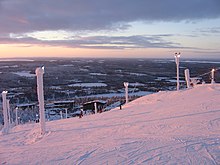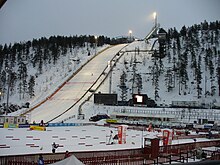Kuusamo
Kuusamo is a major center for winter sports and receives approximately a million tourists every year.
In spring they moved to the rivers and in summer, after the melting of the ice, to the lakes; there they fished and gathered berries and mushrooms; in autumn they hunted reindeer, bears and beavers in the forest.
[citation needed] From the 15th century Finnish fishermen also took advantage of the fishing grounds on the lower reaches of the river Iijoki near Kuusamo.
They took regular trips of a few weeks from Kuusamo, but because the land could not provide hay for the cattle other than near the river, they founded no fixed settlements.
[citation needed] The Swedish–Russian border had already been withdrawn east of Kuusamo in the 1595 Treaty of Teusina, but was long and porous.
With the advent of forestry at the end of the 19th century, workers moved into the area, so Kuusamo reached a population of 10,500 by 1910.
[citation needed] After the independence of Finland in 1917, the Russian border was closed and so Kuusamo was cut off from its hinterland.
In the Moscow Peace Treaty, the Winter War ended on 14 March 1940, Finland lost large parts of Karelia, the eastern areas of Salla and Kuusamo to the Soviet Union.
The ceded part of Kuusamo had an area of 1653 square kilometers and included the villages Paanajärvi, Tavajärvi, Vatajärvi, Enojärvi, Pukari and Kenttikylä.
When it appeared that Germany might lose the war, Finland secretly negotiated a separate peace with the Soviet Union.
As agriculture in the village could not offer enough jobs for the baby boomer generation, the population began to decline rapidly.
The neighboring municipalities of Kuusamo are Suomussalmi in the south, Taivalkoski and Posio in the west, Salla in the north and Russia in the east.
Apart from the city, villages include Alakitka, Heikkilä, Hiltunen, Irni, Jokilampi, Kallunki, Kantokylä, Kemilä, Kero, Kesäniemi, Kiitämäjärvi, Koskenkylä, Kuolio, Kurvinen, Kärpänkylä, Käylä, Lämsänkylä, Maaselänkylä, Murtovaara, Poussu, Puutteenkylä, Rukajärvi, Määttälänvaara, Soivio, Suorajärvi, Tammela, Teeriranta, Törmäsenvaara, Vasaraperä, Virrankylä, Vuotunki, Lehto and Kiviperä.
The highest elevations are Valtavaara (492 m), Kuntivaara (481 m), Iivaara (469 m) and Rukatunturi (492 m), the site of the Ruka ski center.
The largest of the 166 lakes in the area are Joukamojärvi, Kiitämä, Kitka, Kurkijärvi, Kuusamojärvi, Muojärvi and Suininki.
Rivers in the area include Oulankajoki, Kitkajoki, Kuusinkijoki and Pistojoki flowing eastward to the White Sea and Iijoki westward to the Gulf of Bothnia.
The 270 km2 (100 sq mi) area of Oulanka National Park is shared between northern Kuusamo and neighboring Salla municipality.
The landscape is dominated by pine forests, Oulankajoki river and its side branches with their sandbanks and rapids, and in the northern part vast marsh areas.
Near the southern border with Suomussalmi is the canyon lake Julma Ölkky with cliffs up to 50 m (160 ft) high.
Kuusamo is one of the snowiest areas in Finland: the ground is snow-covered for about 200 days a year, from late October until mid-May, with a depth of 80–90 centimetres (31–35 in).
The center of Kuusamo is located approximately 60 km (37 mi) south of the Arctic Circle, thus polar day and night play a major role.
The migration has had an effect on Kuusamo's age structure, as it is mainly young people who leave the town.
[11] The main economic activities in Kuusamo include forestry, reindeer husbandry, small industries and tourism.
[citation needed] In summer, Kuusamo is a popular wilderness destination for fishing, kayaking and hiking.
The most popular hiking trail is Bear's Ring (Karhunkierros), which runs for 80 km (50 mi), mostly in the Oulanka National Park.
[13] While Kuusamo mainly attracts visitors because of its natural environment, the city has produced little of interest in the traditional sense.
[clarification needed] Because the city center was completely destroyed in the Lapland War and then had to be rebuilt quickly and economically, Kuusamo is seen as largely uninteresting from an architectural point of view.
Since 2002, the World Cup kick-off in ski jumping and Nordic combined and cross country skiing World Cup races in Ruka Nordic Opening in late November at a joint event in Kuusamo instead.










